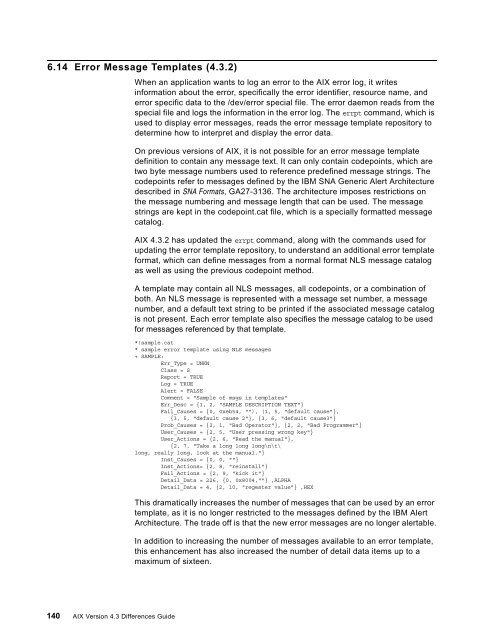AIX Version 4.3 Differences Guide
AIX Version 4.3 Differences Guide
AIX Version 4.3 Differences Guide
You also want an ePaper? Increase the reach of your titles
YUMPU automatically turns print PDFs into web optimized ePapers that Google loves.
6.14 Error Message Templates (<strong>4.3</strong>.2)<br />
When an application wants to log an error to the <strong>AIX</strong> error log, it writes<br />
information about the error, specifically the error identifier, resource name, and<br />
error specific data to the /dev/error special file. The error daemon reads from the<br />
special file and logs the information in the error log. The errpt command, which is<br />
used to display error messages, reads the error message template repository to<br />
determine how to interpret and display the error data.<br />
On previous versions of <strong>AIX</strong>, it is not possible for an error message template<br />
definition to contain any message text. It can only contain codepoints, which are<br />
two byte message numbers used to reference predefined message strings. The<br />
codepoints refer to messages defined by the IBM SNA Generic Alert Architecture<br />
described in SNA Formats, GA27-3136. The architecture imposes restrictions on<br />
the message numbering and message length that can be used. The message<br />
strings are kept in the codepoint.cat file, which is a specially formatted message<br />
catalog.<br />
<strong>AIX</strong> <strong>4.3</strong>.2 has updated the errpt command, along with the commands used for<br />
updating the error template repository, to understand an additional error template<br />
format, which can define messages from a normal format NLS message catalog<br />
as well as using the previous codepoint method.<br />
A template may contain all NLS messages, all codepoints, or a combination of<br />
both. An NLS message is represented with a message set number, a message<br />
number, and a default text string to be printed if the associated message catalog<br />
is not present. Each error template also specifies the message catalog to be used<br />
for messages referenced by that template.<br />
*!sample.cat<br />
* sample error template using NLS messages<br />
+ SAMPLE:<br />
Err_Type = UNKN<br />
Class = S<br />
Report = TRUE<br />
Log = TRUE<br />
Alert = FALSE<br />
Comment = "Sample of msgs in templates"<br />
Err_Desc = {1, 2, "SAMPLE DESCRIPTION TEXT"}<br />
Fail_Causes = {0, 0xeb54, ""), (1, 5, "default cause"},<br />
{3, 5, "default cause 2"}, {3, 6, "default cause3"}<br />
Prob_Causes = {2, 1, "Bad Operator"}, {2, 2, "Bad Programmer"}<br />
User_Causes = {2, 5, "User pressing wrong key"}<br />
User_Actions = {2, 6, "Read the manual"},<br />
{2, 7, "Take a long long long\n\t\<br />
long, really long, look at the manual."}<br />
Inst_Causes = {0, 0, ""}<br />
Inst_Actions= {2, 8, "reinstall"}<br />
Fail_Actions = {2, 9, "kick it"}<br />
Detail_Data = 226, {0, 0x8004,""} ,ALPHA<br />
Detail_Data = 4, {2, 10, "regester value"} ,HEX<br />
This dramatically increases the number of messages that can be used by an error<br />
template, as it is no longer restricted to the messages defined by the IBM Alert<br />
Architecture. The trade off is that the new error messages are no longer alertable.<br />
In addition to increasing the number of messages available to an error template,<br />
this enhancement has also increased the number of detail data items up to a<br />
maximum of sixteen.<br />
140 <strong>AIX</strong> <strong>Version</strong> <strong>4.3</strong> <strong>Differences</strong> <strong>Guide</strong>
















